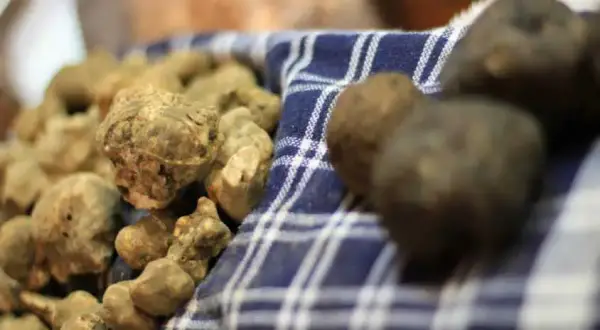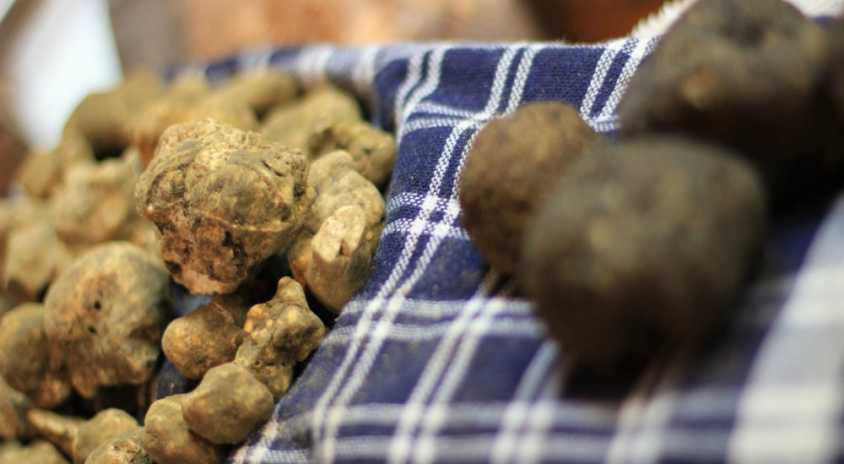White Truffle vs Black Truffle
White Truffle vs Black Truffle

This is a long-running inextricable dispute. What is better white truffles or black truffles? Find out what are the main types of truffles in the world and their characteristics.
This is a long-running inextricable dispute. What is better white truffles or black truffles? Two elements would tip the balance in favor of the first ones: they costs more and are available in few versions, so that the overall average quality keeps high. But this arguments, in technical-scientific terms, are absolutely inconsistent. If the price were the deciding factor, then we should say that the camembert is better than the pecorino cheese. Nonsense. There are several factors which affect the final cost: among others, quantity, ease of retrieval, location of the area of origin, more or better culturability and shelf-life. And the only possible direct comparison should be done among the two excellences: the White “Tuber magnatum Pico”, better known as the White Alba Truffle, and the black “Tuber melanosporum”, better known as Black Truffle of Norcia.
Once again, any comparison would be impossible, because their flavors, texture, and consequently culinary uses are different.
Types of truffles
In the world species of mushrooms currently classified as Tuber are more than 60, but only 9 are considered as edible and 6 are those most commonly traded:
-
White truffle (Tuber Magnatum Pico);
-
Black Truffle (Tuber Melanosporum Vitt);
-
Bianchetto or Marzuolo truffle (Tuber Borchii Vitt);
-
Summer black truffle (Tuber Aestivum Vitt);
-
Fall black truffle (Tuber Uncinatum Chatin);
-
Winter black truffle (Tuber Brumale Vitt);
-
Smooth black truffle (Tuber Macrosporum Vitt).
White Alba truffle or Magnum Pico
White truffle (Tuber Magnatum Pico) is considered as the truffle par excellence due to its considerable commercial importance. Since it grows mainly in Alba (Piedmont, Northern Italy), it is also called Alba white truffle.
It has a globular shape, with numerous holes on the rind that make it very irregular. The surface is smooth and slighlty velvety. The color varies from pale cream to ocher. The inner part (the serfs) is unmistakable and is white or grayish-yellow with small white grains. Its fragrance is unmistakable and strongly aromatic.
White truffles, usually, lives in symbiosis with lime trees, oaks, willows and poplars. The soil must be soft and humid for much of the year, rich in calcium, and there must be a good air circulation. White truffle hunting usually occurs from September to December.
Black Truffle
Black truffle (Tuber Melanosporum Vitt) is also known as Norcia truflle due to the wide presence of this truffle in Umbria, especially around Norcia and Spoleto. It has a rather smooth and rounded shape full of polygonal warts. The blackish brown rind takes on shades of rub rust, while theside is clear. Its aroma is very intense and aromatic. It grows in the hilly and mountainous areas in symbiosis with oak, English oak and hazel. At a commercial level it is considered the most valuable truffle after the white vairety. The Norcia truffle hunting period is usually from December to March.
Bianchetto truffle
The Bianchetto truffle, also called Marzuolo truffle (Tuber Borchii Vitt), by tradition, is highly popualr in the areas of Romagna, Marche and Tuscany, but has a lower commercial value than the white Alba ruffle. It can be confused with it, because originally it comes with the same features: irregular shape, smooth rind, off-white flesh, but when it matures it becomes darker. Also the rind darkens with age. Basically the main characteristic that distinguishes it from the Alba white truffle is the smell, because even if initially the Bianchetto has a delicate and pleasant semll, with passing of timnes it becomes stronger and gets a garlic-like scent. It grows near deciduous and coniferous trees in calcareous soils. The Bianchetto truffle hunting period is from January to March.
Summer truffle or Scorzone
Summer truffle (Tuber Aestivum Vitt), is very similar to Black truffle, and sometimes can reach a considerable size. The outer surface shows pyramidal blackish brown warts and has an intense aromatic smell. You can distinguish it from black truffle when you cut, it, in fact the “gleba”, that is the flesh, is not dark but tends to a dark yellow nuance. It grows both in sandy and clay soils, in deciduous forests. The harvest period usually occurs between May and December.
Fall black truffle
Due to its good organoleptic properties, the demand of Burgundy Truffle, or Fall Black truffle (Tuber Uncinatum Chatin), is steadily increasing.
It is a similar Summer truffle and many experts consider it as a variety of the the aestivum species. Yet, for some, it is a distinct species.
Its “gleba” is dark hazel chocolate, with several clear veins; its smell stronger and more pleasant than Tuber aestivum.
Black winter truffle
Black winter truffle (Tuber Brumale Vitt) is often confused with the black Norcia truffle because they share the same habitat and live in symbiosis with the same type of plants. It has a black and slightly warty rind. Its Gleba is dark with white veins. Its commercial value is halved compared to black truffles. It semlls like nutmeg and usually grows under deciduous trees.
Smooth black truffle
Smooth black truffle (Tuber Macrosporum Vitt), although not very commercialized and little known, is very appreciated. Its surface is smooth and has small warts. It grows in symbiosis with lime trees, oaks, poplars and hazels.
Find out more about Italian truffles, how to use truffle in recipes, and how to store this delicious ingredient at home.
This site contains product affiliate links. We may receive a commission if you make a purchase after clicking on one of these links.


